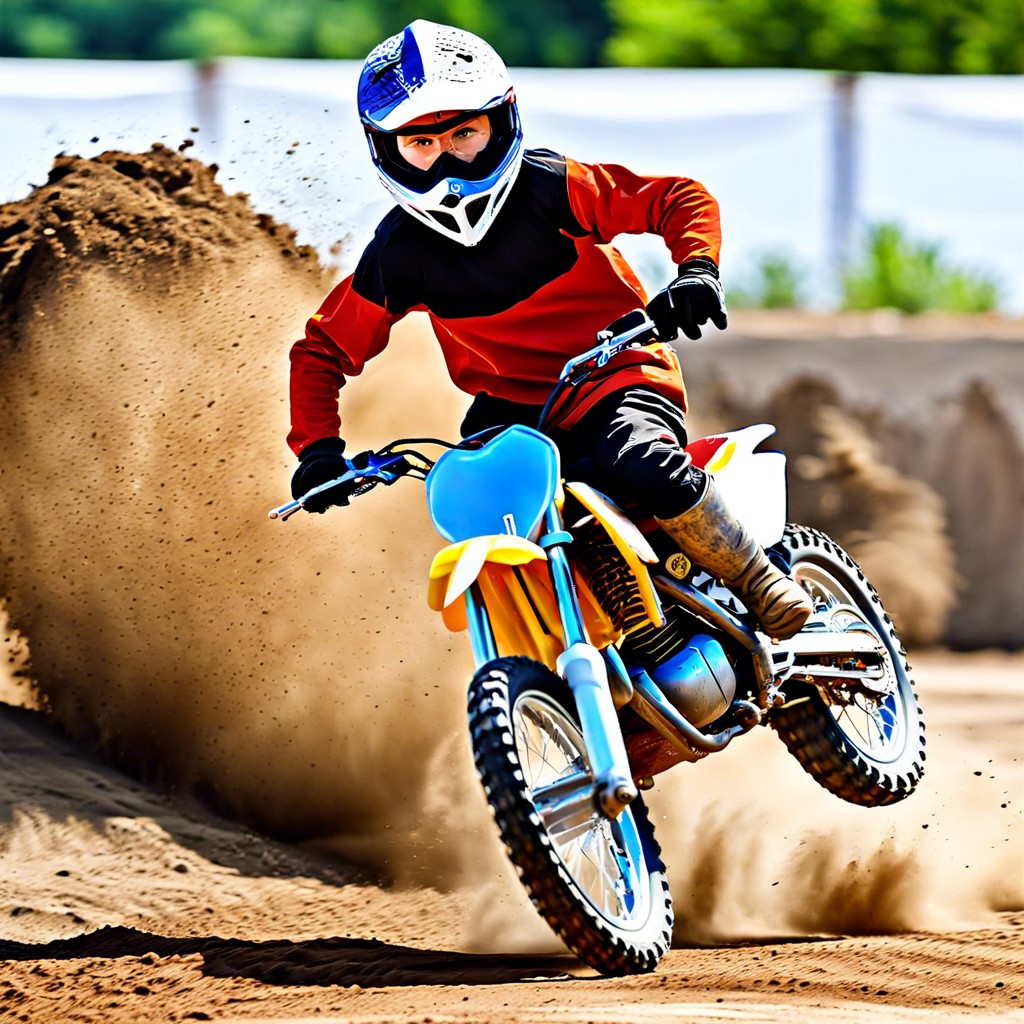In this article, learn about the typical speed capabilities of 125cc dirt bikes and the factors that can influence their performance.
Key takeaways:
- Top speed of a 125cc dirt bike ranges from 55-60 mph.
- Factors influencing speed: engine tuning, rider weight, tire type/pressure, maintenance.
- Track conditions affect speed – hard-packed dirt allows for higher speeds.
- Ruts and wet conditions reduce speed for safety.
- Sprocket gearing affects acceleration and top speed.
Average Top Speed of 125cc Dirt Bike

A 125cc dirt bike typically reaches a top speed in the range of 55 to 60 miles per hour given ideal conditions and a standard configuration. Brands such as Yamaha, Honda, and KTM offer models that may slightly vary in their top speed capabilities due to design and performance tuning. Rider experience also plays a significant role; novices will likely not reach the upper speed echelons that seasoned riders might, owing to differences in confidence and skill. Engine tuning and maintenance state can cause variations in top speed as well – a well-maintained dirt bike is more likely to perform closer to its peak capability. It’s essential to understand that these bikes are designed for agility and handling over rough terrain, not just maximum speed on straightaways.
Factors Affecting the Speed of a 125cc Dirt Bike
Several variables play a pivotal role in the speed output of a 125cc dirt bike. Engine tuning is key; bikes with advanced tuning can harness more power from their engines. Rider weight is another factor; lighter riders will typically experience higher speeds. Tire type and pressure also influence speed, as appropriate traction is necessary for acceleration and handling. Additionally, the bike’s aerodynamics can affect speed, especially in straight-line scenarios. Maintenance is crucial; well-maintained bikes with clean air filters and fresh oil will perform better. Finally, environmental conditions such as elevation and temperature can affect engine performance, thus influencing speed. Understanding these factors allows riders to optimize their bikes for peak performance.
How Track Conditions Impact Speed
Track conditions play a crucial role in determining how fast a 125cc dirt bike can travel. Different types of terrain can either boost speed or act as a hindrance.
Loose surfaces, such as sand or gravel, can cause a loss of traction, reducing a bike’s acceleration and top speed. The tires dig in, and more power is required to maintain momentum, which can lead to a slower overall pace.
On the other hand, hard-packed dirt provides a firmer grip, allowing for better tire traction and enabling the bike to reach higher speeds. The solid surface means less power is lost between the engine and the ground, translating into faster acceleration and higher top speeds.
Ruts and wet conditions can also affect speed. When the ground is rutted, a rider must maneuver carefully, which typically reduces speed to avoid losing control. Wet and muddy conditions decrease tire grip and increase the likelihood of sliding, again necessitating a more measured approach and lower speeds for safety.
Elevation changes must also be considered. Uphill sections naturally slow a bike down as the engine works harder against gravity, while downhill sections can increase speed as gravity assists in acceleration.
Understanding the interplay between track conditions and bike performance is crucial for riders to adapt their riding style and gear settings for optimal speed. Adjusting tire pressure, choosing the right tread pattern, and being mindful of environmental factors can help maintain speed across varying terrain.
Sprocket Gearing and Speed
Gearing ratios play a pivotal role in the performance of 125cc dirt bikes. Here’s how the sprocket’s teeth count influences both top-end speed and acceleration:
The front sprocket, or countershaft sprocket, connected to the clutch, drives the chain. More teeth equate to higher top speeds but slower acceleration. Conversely, fewer teeth translate to faster acceleration but lower top speeds.
Rear sprocket adjustments have a more pronounced effect; a higher teeth count boosts torque and improves acceleration, making it easier to tackle steep inclines or challenging terrain. However, this comes at the expense of maximum speed.
Balancing these two sprockets is critical to fine-tuning performance according to riding conditions and style. Achieving the optimal balance means maximizing the 125cc engine’s potential, whether for competitive racing or leisure trail riding.
Changing sprockets is a common tweak for riders looking to customize their dirt bike’s power delivery. The stock set-up is a compromise designed to offer good overall performance but can be improved upon with selective gearing changes tailored to specific conditions.